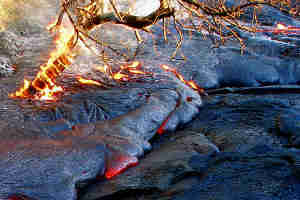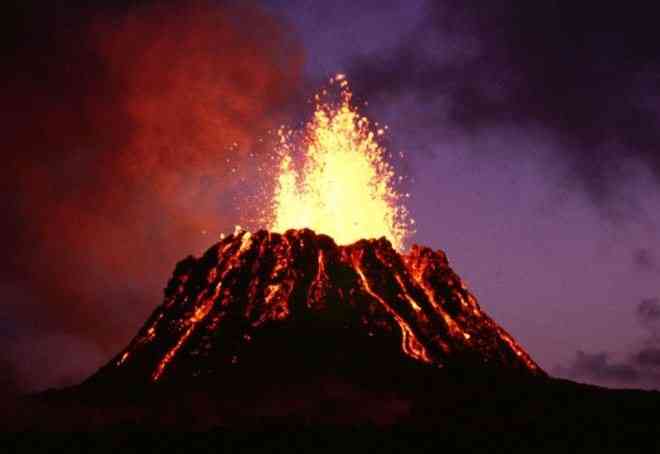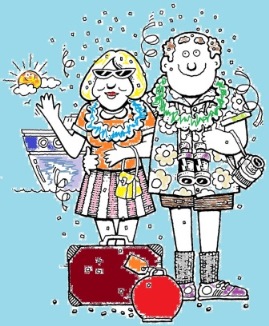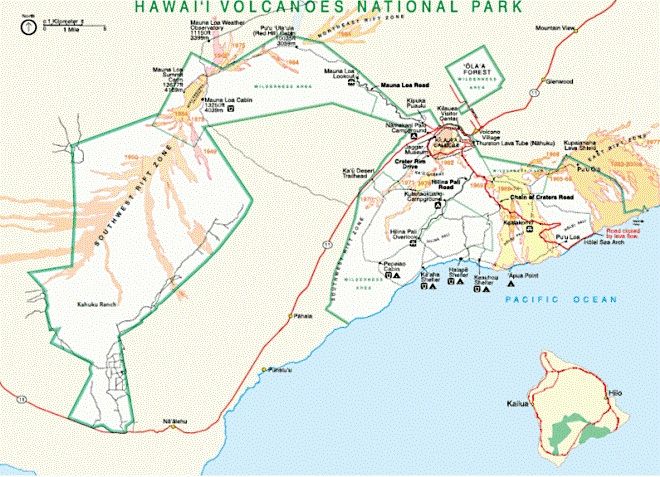Visit Hawaii. Travel destination Volcanoes National Park. Learn about Volcanoes and take the easy quiz.
Hawaii Volcanoes National Park
In 1916 Volcanoes National Park was established in Hawaii. The park is on the big island of Hawaii. The park includes 323,431 acres (505.36 sq mi; 1,308.88 km2) of land. It encompasses two active volcanoes: Kīlauea, one of the world’s most active volcanoes, and Mauna Loa, the world’s most massive subaerial volcano. Scientists gain insight into the birth of the Hawaiian Islands and ongoing studies into the processes of vulcanism through the two volcanoes in the park.
The park offers dramatic volcanic landscapes for visitors, as well as glimpses of rare flora and fauna on the island.
In 1980 Hawaii Volcanoes National Park was designated as an International Biosphere Reserve in recognition of its outstanding natural values. Later in 1987 it was designated a World Heritage Site. In 2012 the Hawaii Volcanoes National Park was honored on the 14th quarter of the America the Beautiful Quarters series.
Over half of the park is designated the Hawaii Volcanoes Wilderness area and provides unusual hiking and camping opportunities. The park encompasses diverse environments that range from sea level to the summit of the Earth’s most massive active volcano, Mauna Loa at 13,677 feet (4,169 meters). Climates range from lush tropical rain forests, to the arid and barren Kau Desert.
The main entrance to the park is from the Hawaii Belt Road. The Chain of Craters Road, as the name implies, leads past several craters from historic eruptions to the coast.

Tree on fire in active lava flow, Hawaii Volcanoes National Park, USA near the Royal Gardens subdivision. photo © Brian W. Schaller / CC-BY-NC-SA-3.0
A Brief History
Kīlauea and its Halemaumau caldera were traditionally considered the sacred home of the volcano goddess Pele, and Hawaiians visited the crater to offer gifts to the goddess. In 1790, a party of warriors (along with women and children who were in the area) were caught in an unusually violent eruption. Many were killed and others left footprints in the lava that can still be seen today. In 1823 The first western visitors to the site, English missionary William Ellis and American Asa Thurston, went to Kīlauea. Ellis wrote of his reaction to the first sight of the erupting volcano:
A spectacle, sublime and even appalling, presented itself before us. ‘We stopped and trembled.’ Astonishment and awe for some moments rendered us mute, and, like statues, we stood fixed to the spot, with our eyes riveted on the abyss below.
By 1840s the volcano became a tourist attraction. Local businessmen ran a series of hotels at the rim. Volcano House is the only hotel or restaurant located within the borders of the National Park. In 2004, an additional 115,788 acres of Kahuku Ranch were added to the park, making it 56% larger.
Geologic History
Hawaii Volcanoes National Park, located on the island of Hawaii, is at the young end of the 1700-mile stretch of islands. The islands are fairly young, from less than 1 million years at the youngest to nearly 6 million at the oldest. New formations continue to be formed even today. The development of the Hawaii islands is due to the five shield volcanoes that erupted during the Pleistocene Period.
The largest tectonic plate on earth, the Pacific plate, is where the islands are located and sit on. One of the volcanoes, Mauna Loa, has an elevation of 13,680 feet and a 70-mile long by 30-mile wide shield-shaped dome. It is the world’s largest active volcano, encompassing 10,000 cubic miles. Similarly, Kilauea also has a shield shaped dome, which is 50 miles long and 14 miles wide. Both volcanoes release more fluid and less gaseous eruptions, which produce fiery type fountains and literally rivers of molten lava. Due to these eruptions, a desert-like volcanic landscape has resulted in the park.
Some Historic Places
There are some places listed on the National Register of Historic Places on the Island of Hawaii. Here are a few:
- Kilauea Crater
- Wilkes Campsite
- 1790 Footprints
- Ainapo Trail
- Puna-Ka’u Historic District
- Whitney Seismograph Vault No. 29
- Ainahou Ranch
- Volcano House

Lava erupting from the Puu Oo vent
The main visitor center, located just within the park entrance includes displays and information about the features of the park.
The nearby Volcano Art Center, located in the original 1877 Volcano House hotel, is listed on the National Register of Historic Places and now houses historical displays and an art gallery.
The Thomas A. Jaggar Museum, located a few miles west on Crater Rim Drive, features more exhibits and a close view of the Kilauea’s active vent Halemaumau.
The Hawaiian Volcano Observatory, which adjoins the museum. The observatory itself is operated by the U.S. Geological Survey but is not open to the public.
Quick Info
Kilauea Visitor Center
Open daily: 7:45 am to 5 pm
You can begin your visit at the Kilauea Visitor Center. Here you can watch a film during the hours from 9 am to 4 pm to introduce you to the park. You can learn about hikes in the park and get the latest eruption updates. Ranger-guided activities can be scheduled plus ranger talks are also offered.
Crater Rim Drive
Crater Rim Drive is the ten and a half mile drive that circles Kilauea Caldera. Driving this loop will take you to the park’s main attractions. You’ll be able to see or visit the Kilauea overlook, Halemaumau Crater, Devastation Trail, Jaggar Museum, Kilauea Iki Crater Overlook and the Thurston Lava Tube.
Thomas A. Jaggar Museum
Open daily: 8:30 am to 5 pm
Here you can find geologic displays, videos and maps about the study of volcanoes.
Halemaumau Crater
known as the home of Pele, the volcano goddess is where you can see vents with plumes of steam coming from this giant crater, known as the home of Pele, the volcano goddess. Back in 1967 the crater was filled with a lake of lava that eventually drained away. This is a sacred site, great respect should be paid here.
There are other attractions in the park besides the few mentioned above. Be sure to check times and days for any of the park’s attractions in case they have changed.
View the pictures and read article above BEFORE taking quiz.
Take this quiz about Hawaii Volcanoes National Park and see how much you’ve learned or remember.
Answer all questions. Each answer is worth 10 points. If you don’t know the answer, then take a guess (unless you want a guaranteed zero for the answer). This test is timed (3 min) so be aware of that. This is a great park to visit if you are in Hawaii. It is on the big island of Hawaii which you are almost sure to visit if you go to Hawaii, especially for the first time. Add this to your list of “must see” places to visit. To learn more about Hawaii click any of the links below which will take you to our main travel site.
Hawaii – a Popular Vacation Destination
Quiz #8 Volcanoes National Park
 This Travel Quiz Weekly Quiz is about Hawaii Volcanoes National Park. This is a true false quiz. The level of this test is medium.
This Travel Quiz Weekly Quiz is about Hawaii Volcanoes National Park. This is a true false quiz. The level of this test is medium.
Click Start Quiz below to take the quiz.
Beauty of Molokai
Maui a Natural Wonderland of Hawaii
Flowing Lava in Hawai’i Volcanoes National Park, Hawai’i, the Big Island
Uploaded to YouTube on Aug 11, 2012
This is flowing lava (pahoehoe) erupting from Kilauea recorded inside Hawai’i Volcanoes National Park in May 2012.
Do you have travel perception? Buy my TravelPerception.com and I’ll build you a simple travel website. CLICK HERE.











